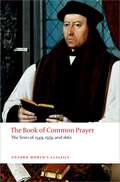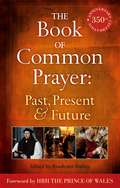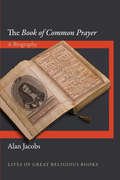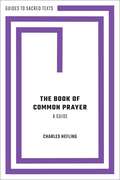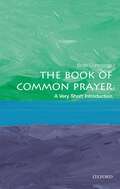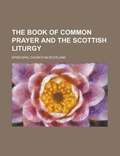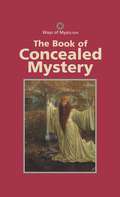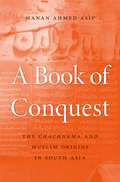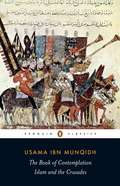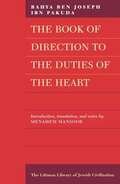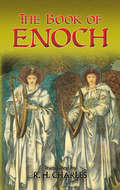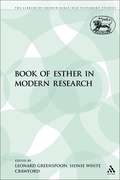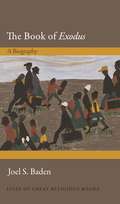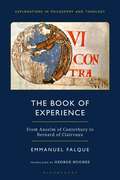- Table View
- List View
The Book Of Common Prayer: The Texts of 1549, 1559, and 1662 (Very Short Introductions Ser.)
by Brian Cummings'In the midst of life we are in death.' The words of the Book of Common Prayer have permeated deep into the English language all over the world. For nearly 500 years, and for countless people, it has provided a background fanfare for a marriage or a funeral march at a burial. Yet this familiarity also hides a violent and controversial history. When it was first produced the Book of Common Prayer provoked riots and rebellion, and it was banned before being translated into a host of global languages and adopted as the basis for worship in the USA and elsewhere to the present day. This edition presents the work in three different states: the first edition of 1549, which brought the Reformation into people's homes; the Elizabethan prayer book of 1559, familiar to Shakespeare and Milton; and the edition of 1662, which embodies the religious temper of the nation down to modern times. 'magnificent edition' Diarmaid MacCulloch,London Review of Books 'superb edition...excellent notes and introduction' Rowan Williams, Times Literary Supplement ABOUT THE SERIES: For over 100 years Oxford World's Classics has made available the widest range of literature from around the globe. Each affordable volume reflects Oxford's commitment to scholarship, providing the most accurate text plus a wealth of other valuable features, including expert introductions by leading authorities, helpful notes to clarify the text, up-to-date bibliographies for further study, and much more.
The Book of Common Prayer: A 350th Anniversary Celebration
by Prudence DaileyThe words of The Book of Common Prayer have worked their way deeply into the hearts and minds of English-speaking people, second only to the English Bible and the works of Shakespeare. This collection of essays seeks not only to explore and commemorate the Book of Common Prayer's influence in the past but also to commend it for present use, and as an indispensable part of the Church's future -- both as a working liturgy and as the definitive source of Anglican doctrine.
The Book of Common Prayer: A 350th Anniversary Celebration
by Prudence DaileyThe words of The Book of Common Prayer have worked their way deeply into the hearts and minds of English-speaking people, second only to the English Bible and the works of Shakespeare. This collection of essays seeks not only to explore and commemorate the Book of Common Prayer's influence in the past but also to commend it for present use, and as an indispensable part of the Church's future -- both as a working liturgy and as the definitive source of Anglican doctrine.
The "Book of Common Prayer": A Biography
by Alan JacobsWhile many of us are familiar with such famous words as, "Dearly beloved, we are gathered together here. . ." or "Ashes to ashes, dust to dust," we may not know that they originated with The Book of Common Prayer, which first appeared in 1549. Like the words of the King James Bible and Shakespeare, the language of this prayer book has saturated English culture and letters. Here Alan Jacobs tells its story. Jacobs shows how The Book of Common Prayer--from its beginnings as a means of social and political control in the England of Henry VIII to its worldwide presence today--became a venerable work whose cadences express the heart of religious life for many. The book's chief maker, Thomas Cranmer, Archbishop of Canterbury, created it as the authoritative manual of Christian worship throughout England. But as Jacobs recounts, the book has had a variable and dramatic career in the complicated history of English church politics, and has been the focus of celebrations, protests, and even jail terms. As time passed, new forms of the book were made to suit the many English-speaking nations: first in Scotland, then in the new United States, and eventually wherever the British Empire extended its arm. Over time, Cranmer's book was adapted for different preferences and purposes. Jacobs vividly demonstrates how one book became many--and how it has shaped the devotional lives of men and women across the globe.
The "Book of Common Prayer": A Biography
by Alan JacobsWhile many of us are familiar with such famous words as, "Dearly beloved, we are gathered together here. . ." or "Ashes to ashes, dust to dust," we may not know that they originated with The Book of Common Prayer, which first appeared in 1549. Like the words of the King James Bible and Shakespeare, the language of this prayer book has saturated English culture and letters. Here Alan Jacobs tells its story. Jacobs shows how The Book of Common Prayer--from its beginnings as a means of social and political control in the England of Henry VIII to its worldwide presence today--became a venerable work whose cadences express the heart of religious life for many. The book's chief maker, Thomas Cranmer, Archbishop of Canterbury, created it as the authoritative manual of Christian worship throughout England. But as Jacobs recounts, the book has had a variable and dramatic career in the complicated history of English church politics, and has been the focus of celebrations, protests, and even jail terms. As time passed, new forms of the book were made to suit the many English-speaking nations: first in Scotland, then in the new United States, and eventually wherever the British Empire extended its arm. Over time, Cranmer's book was adapted for different preferences and purposes. Jacobs vividly demonstrates how one book became many--and how it has shaped the devotional lives of men and women across the globe.
The Book of Common Prayer: A Biography (Lives of Great Religious Books #18)
by Alan JacobsWhile many of us are familiar with such famous words as, "Dearly beloved, we are gathered together here. . ." or "Ashes to ashes, dust to dust," we may not know that they originated with The Book of Common Prayer, which first appeared in 1549. Like the words of the King James Bible and Shakespeare, the language of this prayer book has saturated English culture and letters. Here Alan Jacobs tells its story. Jacobs shows how The Book of Common Prayer--from its beginnings as a means of social and political control in the England of Henry VIII to its worldwide presence today--became a venerable work whose cadences express the heart of religious life for many. The book's chief maker, Thomas Cranmer, Archbishop of Canterbury, created it as the authoritative manual of Christian worship throughout England. But as Jacobs recounts, the book has had a variable and dramatic career in the complicated history of English church politics, and has been the focus of celebrations, protests, and even jail terms. As time passed, new forms of the book were made to suit the many English-speaking nations: first in Scotland, then in the new United States, and eventually wherever the British Empire extended its arm. Over time, Cranmer's book was adapted for different preferences and purposes. Jacobs vividly demonstrates how one book became many--and how it has shaped the devotional lives of men and women across the globe.
The Book of Common Prayer: A Biography (Lives of Great Religious Books #18)
by Alan JacobsWhile many of us are familiar with such famous words as, "Dearly beloved, we are gathered together here. . ." or "Ashes to ashes, dust to dust," we may not know that they originated with The Book of Common Prayer, which first appeared in 1549. Like the words of the King James Bible and Shakespeare, the language of this prayer book has saturated English culture and letters. Here Alan Jacobs tells its story. Jacobs shows how The Book of Common Prayer--from its beginnings as a means of social and political control in the England of Henry VIII to its worldwide presence today--became a venerable work whose cadences express the heart of religious life for many. The book's chief maker, Thomas Cranmer, Archbishop of Canterbury, created it as the authoritative manual of Christian worship throughout England. But as Jacobs recounts, the book has had a variable and dramatic career in the complicated history of English church politics, and has been the focus of celebrations, protests, and even jail terms. As time passed, new forms of the book were made to suit the many English-speaking nations: first in Scotland, then in the new United States, and eventually wherever the British Empire extended its arm. Over time, Cranmer's book was adapted for different preferences and purposes. Jacobs vividly demonstrates how one book became many--and how it has shaped the devotional lives of men and women across the globe.
The Book of Common Prayer: The Texts of 1549, 1559, and 1662 (Oxford World's Classics)
'In the midst of life we are in death.' The words of the Book of Common Prayer have permeated deep into the English language all over the world. For nearly 500 years, and for countless people, it has provided a background fanfare for a marriage or a funeral march at a burial. Yet this familiarity also hides a violent and controversial history. When it was first produced the Book of Common Prayer provoked riots and rebellion, and it was banned before being translated into a host of global languages and adopted as the basis for worship in the USA and elsewhere to the present day. This edition presents the work in three different states: the first edition of 1549, which brought the Reformation into people's homes; the Elizabethan prayer book of 1559, familiar to Shakespeare and Milton; and the edition of 1662, which embodies the religious temper of the nation down to modern times. 'magnificent edition' Diarmaid MacCulloch,London Review of Books 'superb edition...excellent notes and introduction' Rowan Williams, Times Literary Supplement ABOUT THE SERIES: For over 100 years Oxford World's Classics has made available the widest range of literature from around the globe. Each affordable volume reflects Oxford's commitment to scholarship, providing the most accurate text plus a wealth of other valuable features, including expert introductions by leading authorities, helpful notes to clarify the text, up-to-date bibliographies for further study, and much more.
The Book of Common Prayer: A Guide (Guides to Sacred Texts)
by Charles HeflingThe Book of Common Prayer is a remarkable book, a sacred book in more than one sense. It is primarily a liturgical text, meant to be used in corporate worship, and at the same time a literary landmark, a cultural icon, and a focus of identity for Anglican Christianity. This brief, accessible account of the Prayer Book, as it is often called, describes the contents of the classical version of the text, with special emphasis on the services for which it has been used most frequently since it was issued in 1662. Charles Hefling also examines the historical and theological context of the Prayer Book's origins, the changes it has undergone, the controversies it has touched off, and its reception in England, Scotland, and America. Readers are introduced to the political as well as the spiritual influence of the Book of Common Prayer, and to its enduring place in English-speaking religion.
The Book of Common Prayer: A Very Short Introduction (Very Short Introductions)
by Brian CummingsThe Book of Common Prayer is one of the most influential books in history. First published in the reign of Edward VI, in 1549, it was a product of the English Reformation following the break with Rome. For nearly five centuries, it has formed the order of worship for established Christianity in England. More listeners have heard these prayers, it is said, than the soliloquies of Shakespeare. As British imperial ambitions spread, the Book of Common Prayer became the primary instrument (at least as much as the King James Bible) of English culture, firstly in Ireland in 1551. When the Puritans fled to America in 1620 it was to escape the discipline imposed by of the Book of Common Prayer, yet the book came to embody official religion in America before and after Independence, and is still in use. Today it is a global book: it was the first book printed in many languages, from north America to southern Africa, to the Indian sub-continent. In this Very Short Introduction Brian Cummings tells the fascinating history of the Book of Common Prayer, and explains why it is easily misunderstood. Designed in the 1540s as a radical Protestant answer to Catholic "superstition", within a century (during the English Civil Wars) radical Christians regarded the Book of Common Prayer as itself "superstitious" and even (paradoxically) "Papist". Changing in meaning and context over time, the Book of Common Prayer has acted as a cultural symbol, affecting the everyday conduct of life as much as the spiritual, and dividing conformity from non-conformity, in social terms as well as religious, from birth to marriage to death. ABOUT THE SERIES: The Very Short Introductions series from Oxford University Press contains hundreds of titles in almost every subject area. These pocket-sized books are the perfect way to get ahead in a new subject quickly. Our expert authors combine facts, analysis, perspective, new ideas, and enthusiasm to make interesting and challenging topics highly readable.
The Book of Common Prayer: A Very Short Introduction (Very Short Introductions)
by Brian CummingsThe Book of Common Prayer is one of the most influential books in history. First published in the reign of Edward VI, in 1549, it was a product of the English Reformation following the break with Rome. For nearly five centuries, it has formed the order of worship for established Christianity in England. More listeners have heard these prayers, it is said, than the soliloquies of Shakespeare. As British imperial ambitions spread, the Book of Common Prayer became the primary instrument (at least as much as the King James Bible) of English culture, firstly in Ireland in 1551. When the Puritans fled to America in 1620 it was to escape the discipline imposed by of the Book of Common Prayer, yet the book came to embody official religion in America before and after Independence, and is still in use. Today it is a global book: it was the first book printed in many languages, from north America to southern Africa, to the Indian sub-continent. In this Very Short Introduction Brian Cummings tells the fascinating history of the Book of Common Prayer, and explains why it is easily misunderstood. Designed in the 1540s as a radical Protestant answer to Catholic "superstition", within a century (during the English Civil Wars) radical Christians regarded the Book of Common Prayer as itself "superstitious" and even (paradoxically) "Papist". Changing in meaning and context over time, the Book of Common Prayer has acted as a cultural symbol, affecting the everyday conduct of life as much as the spiritual, and dividing conformity from non-conformity, in social terms as well as religious, from birth to marriage to death. ABOUT THE SERIES: The Very Short Introductions series from Oxford University Press contains hundreds of titles in almost every subject area. These pocket-sized books are the perfect way to get ahead in a new subject quickly. Our expert authors combine facts, analysis, perspective, new ideas, and enthusiasm to make interesting and challenging topics highly readable.
The Book of Common Prayer / and The Scottish Liturgy
by Episcopal Church in ScotlandPrayerbook of the Episcopal Church in Scotland
BOOK OF COMMON PRAYER GST C: A Worldwide Survey (Guides to Sacred Texts)
by Charles HeflingThe Book of Common Prayer is a remarkable book, a sacred book in more than one sense. It is primarily a liturgical text, meant to be used in corporate worship, and at the same time a literary landmark, a cultural icon, and a focus of identity for Anglican Christianity. This brief, accessible account of the Prayer Book, as it is often called, describes the contents of the classical version of the text, with special emphasis on the services for which it has been used most frequently since it was issued in 1662. Charles Hefling also examines the historical and theological context of the Prayer Book's origins, the changes it has undergone, the controversies it has touched off, and its reception in England, Scotland, and America. Readers are introduced to the political as well as the spiritual influence of the Book of Common Prayer, and to its enduring place in English-speaking religion.
The Book of Concealed Mystery
by ContinuumThis is a book of the key text of the Kabbalah, a work known as the Zohar ("Splendour"). The Zohar is a commentary on the Torah and although it is sometimes ascribed to a second-century rabbi, Simon Bar-Yochai, the form in which it is most widely known originates with Moses of Leon, a native of Granada, who died in 1305.The kabbalists believe that the undefinable origin of all things is Ein Sof - the cause of causes, the infinite, that which underlies everything. The universe emanates from the divine in successive layers called esefiroti. Everything exists in God, but God extends infinitely beyond existence. All we know and are is linked together, pervaded and maintained by the divine. According to this work, the light of God must be concealed in order to be revealed to creation. Even though the kabbalists believe that ultimately Ein Sof is beyond expression or understanding, the contemplation of God's presence in all things causes our thoughts to be purified.
A Book of Conquest: The Chachnama And Muslim Origins In South Asia
by Manan Ahmed AsifManan Ahmed Asif shows that the Chachnama is a sophisticated work of political theory, embedded in both the Indic and Islamic ethos. His social and intellectual history of this text offers an important corrective to the divisions between Muslim and Hindu that so often define Pakistani and Indian politics today.
A Book of Conquest: The Chachnama And Muslim Origins In South Asia
by Manan Ahmed AsifManan Ahmed Asif shows that the Chachnama is a sophisticated work of political theory, embedded in both the Indic and Islamic ethos. His social and intellectual history of this text offers an important corrective to the divisions between Muslim and Hindu that so often define Pakistani and Indian politics today.
The Book of Contemplation: Islam and the Crusades
by Usama Ibn MunqidhThe volume comprises lightly annotated translation of a key medieval Arabic text that bears directly on the Crusades and Crusader society and the Muslim experience of them.
Book of Daniel: An Annotated Bibliography
by Henry O. Thompson'Book of Daniel' An Annotated Bibliography, This volume is one of a series of bibliographies on the books of the Bible. This is the first volume of the series of bibliographies described in the series introduction, in this case on the Book of Daniel in the Old Testament (OT) or the Hebrew Scriptures fTanakh).Scholars for these bibliographies have been drawn from across the Judeo-Christian perspective as well as across doctrinal perspectives. These bibliographies should be of value to students and faculty, to laity and professional, to religious and academic groups, for undergraduate and graduate study. They should serve a significant role as reference works in libraries for the public, the university, and religious groups, as well as individuals.
Book of Daniel: An Annotated Bibliography (Books Of The Bible Ser. #Vol. 1)
by Henry O. Thompson'Book of Daniel' An Annotated Bibliography, This volume is one of a series of bibliographies on the books of the Bible. This is the first volume of the series of bibliographies described in the series introduction, in this case on the Book of Daniel in the Old Testament (OT) or the Hebrew Scriptures fTanakh).Scholars for these bibliographies have been drawn from across the Judeo-Christian perspective as well as across doctrinal perspectives. These bibliographies should be of value to students and faculty, to laity and professional, to religious and academic groups, for undergraduate and graduate study. They should serve a significant role as reference works in libraries for the public, the university, and religious groups, as well as individuals.
The Book of Direction to the Duties of the Heart (The Littman Library of Jewish Civilization)
by Bahya Ben PakudaBahya Ibn Pakuda was born c. 1050, and lived for some time in Saragossa in Spain. His major work was written in Arabic, but it is most well-known by its Hebrew title Hovot ha-Levavot (Duties of the Heart). It enjoyed enormous popularity and was reprinted many times. In the book Bahya investigates the motivation of Jewish practice and embarks on a philosophical enquiry into the nature of God, religion, and man. He was very much influenced by the Neoplatonism of his age, as well as by the Muslim mystics. This edition by Menahem Mansoor is the first translation of the work from the original Arabic text, and this shows a number of variations from the Hebrew version. He has added an Introduction and Notes which draw attention to the influences on Bahya’s thought and to other relevant material. ‘The accepted and normative translation . . . reliable and readable. This book belongs in even the smallest collections of Judaica, as well as of ethical literature.’ Choice
The Book of Enoch
by R. H. CharlesR. H. Charles provides a definitive translation of one of the most noted apocalyptic works still in existence. Often described as "the lost book" of the Bible, The Book of Enoch seems to have been written in Palestine by several different authors in the first and second centuries B.C. For hundreds of years it was accepted by the early church fathers, but it was rejected by the council of Laodicea in A.D. 364. Today, it remains a written remnant of the Apocalypse—an ardent testament to hope and the triumph of good over evil in the dawning of a world to come. Rife with concepts of original sin, fallen angels, demonology, resurrection, and the last judgment, it is a vital document to the origins of Christianity.The Book of Enoch is comprised of various monumental works: The Book of Enoch, The Parables, The Book of the Courses of the Heavenly Luminaries, The Dream Visions, The Concluding Section, and The Noah Fragments. Each work is independent, but all the works are bound by a common theme: the punishment of the wicked and the blessedness of the righteous. This edition, complete with analysis and notes, is an indispensable resource for the study and understanding of both the Old and New Testaments.
The Book of Esther in Modern Research (The Library of Hebrew Bible/Old Testament Studies)
by Leonard Greenspoon Sidnie White CrawfordThe proceedings of a symposium entitled Esther 2000 held in Lincoln and Omaha, Nebraska in April 2000, the book contains a collection of essays that engages all aspects of the biblical book of Esther. From questions of textual criticism to the history of rabbinic interpretation to speculation on the modern form of commentary, this collection is sure to contain something for everyone interested in the book of Esther. Contributors include such well-known Esther scholars as Michael Fox, David Clines, and Carey Moore.
The Book of Exodus: A Biography (Lives of Great Religious Books #48)
by Joel S. BadenAn essential biography of one of the Bible’s most powerful and inspiring booksExodus is the second book of the Hebrew Bible, but it may rank first in lasting cultural importance. It is here that the classic biblical themes of oppression and redemption, of human enslavement and divine salvation, are most dramatically expressed. Joel Baden tells the story of this influential and enduring book, tracing how its famous account of the Israelites’ journey to the promised land has been adopted and adapted for millennia, often in unexpected ways.Baden draws a distinction between the Exodus story and the book itself, which is one of the most multifaceted in the Bible, containing poems, law codes, rituals, and architectural plans. He shows how Exodus brings together an array of oral and written traditions from the ancient Middle East, and how it came to be ritualized in the Passover Seder and the Eucharist. Highlighting the remarkable resilience and flexibility of Exodus, Baden sheds light on how the bestowing of the Torah to Moses on Mount Sinai divided Jewish and Christian thinkers, on the importance of Exodus during the Reformation and the American Revolution, and on its uses in debates for and against slavery. He also traces how the defining narrative of ancient Israel helped to define Mormon social identity, the American civil rights movement, and liberation theology.Though three thousand years old, the Exodus—as history, as narrative, as metaphor, as model—continues to be vitally important for us today. Here is the essential biography of this incomparable spiritual masterpiece.
The Book of Exodus: A Biography (Lives of Great Religious Books #48)
by Joel S. BadenAn essential biography of one of the Bible’s most powerful and inspiring booksExodus is the second book of the Hebrew Bible, but it may rank first in lasting cultural importance. It is here that the classic biblical themes of oppression and redemption, of human enslavement and divine salvation, are most dramatically expressed. Joel Baden tells the story of this influential and enduring book, tracing how its famous account of the Israelites’ journey to the promised land has been adopted and adapted for millennia, often in unexpected ways.Baden draws a distinction between the Exodus story and the book itself, which is one of the most multifaceted in the Bible, containing poems, law codes, rituals, and architectural plans. He shows how Exodus brings together an array of oral and written traditions from the ancient Middle East, and how it came to be ritualized in the Passover Seder and the Eucharist. Highlighting the remarkable resilience and flexibility of Exodus, Baden sheds light on how the bestowing of the Torah to Moses on Mount Sinai divided Jewish and Christian thinkers, on the importance of Exodus during the Reformation and the American Revolution, and on its uses in debates for and against slavery. He also traces how the defining narrative of ancient Israel helped to define Mormon social identity, the American civil rights movement, and liberation theology.Though three thousand years old, the Exodus—as history, as narrative, as metaphor, as model—continues to be vitally important for us today. Here is the essential biography of this incomparable spiritual masterpiece.
The Book of Experience: From Anselm of Canterbury to Bernard of Clairvaux (Explorations in Philosophy and Theology)
by Emmanuel FalqueEmmanuel Falque, one of the foremost philosophers working in the continental philosophy of religion today, takes us by the hand into the very heart of 12th-century monastic spirituality.Translated into English for the first time, The Book of Experience weaves together contemporary phenomenological questions with medieval theology, revealing undiscovered dialogues already underway between Hugh of St. Victor and Maurice Merleau-Ponty, between Richard of St. Victor and Emmanuel Levinas, between Aelred of Rievaulx and Michel Henry, and not least between Bernard of Clairvaux and the trio of Descartes, Heidegger, and Jean-Luc Marion, consummating in a masterful phenomenological reading of Bernard's sermons on the Song of Songs. Whether it is a question of 'the idea that comes to God' (Anselm of Canterbury) or actively 'feeling oneself fully alive' (Aelred of Rievaulx or Bernard of Clairvaux), Falque uses these encounters to shed light on both parties, medieval and modern, theological and philosophical. Leading us through works of art, landscapes, architectures, and liturgies, this major contemporary philosopher of religion clarifies mysteries and discovers experience lying at the heart of the medieval tradition.
